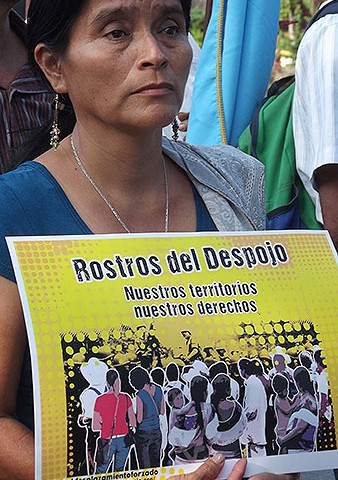
IN FOCUS: “There is no news that is worth a life” – The courageous work of communicators in Mexico
21/02/2015SIPAZ ACTIVITIES (From mid-November 2014 to mid-February 2015)
21/02/2015“What we want is to return. Because our lands and homes are there; all of our belongings are still there.”
Petrona López Girón, displaced from Banavil
“I can see that the government has no desire to resolve our problems, and that’s why we will demand justice. We will not give up; we will continue the struggle.”
Miguel López Girón, displaced from Banavil
On 13 November 2014, more than 600 people observed the eighth anniversary of the Viejo Velasco massacre by engaging in a pilgrimage in Palenque, Chiapas. On this same day in 2006, 40 civilians from the Lacandon community and sub-communards from Nueva Palestina, as well as a group of approximately 300 armed members of the former State Sectorial Police, entered the Viejo Velasco community in the municipality of Ocosingo. It became clear to the residents that they would have to flee from their homes and lands. The attack resulted in the death of four indigenous people, the disappearance of another four, and the displacement of thirty-six individuals. Among the disappeared, two were later found dead, while the whereabouts of Mariano Pérez Guzmán and Antonio Peñate López continue to be unknown. During the march, Beyond calling for the disappeared persons to be returned alive, the protestors also demanded an end to impunity. The Fray Bartolomé de Las Casas Center for Human Rights (CDHFBC) has reported that, “the line of investigation from the Chiapas State Attorney General has been ineffective.”
© SIPAZ
This pilgrimage also marked the beginning of the “Faces of Pillage” campaign, organized by 12 Mexican organizations, in conjunction with international groups from Spain, Germany, the United States, and Russia. In discussing the Viejo Velasco case alongside two others, the campaign seeks to generate a movement of national and international solidarity to make human-rights violations visible in Chiapas, to exercise pressure, and demand the observance of the obligations of the Mexican State. At the website www.rostrosdeldespojo.org information is provided regarding news, updates, video documentaries, and a petition presenting the aforementioned demands addressed to the appropriate authorities. Beyond this, it calls for local events that would give voice to “Faces of Pillage,” as well as action-days for international solidarity. The second such day will begin on 8 March, International Women’s Day, to call attention to the especially vulnerable situation of displaced women and children.
The other examples that are considered in the campaign are the forcible displacements in Banavil and San Marcos Avilés. On 4 December 2011 in the Banavil community, Tenejapa municipality, members of the Institutional Revolutionary Party (PRI) attacked families which sympathize with the Zapatista Army of National Liberation (EZLN) using firearms. The assault resulted in the death of Pedro Méndez López and the forcible disappearance of Alonso López Luna, whose arm was later recovered. Six other people were injured and two arbitrarily arrested. Thirteen others are still among the displaced in San Cristóbal de Las Casas, robbed of their lands, their means of their economic survival, and their cultural lives.
San Marcos Avilés, Chilón municipality, was founded after the Zapatista uprising in 1994. In 2010, the Zapatista support bases (BAEZLN) agreed to build an autonomous school for their children, but they soon faced a confrontation with a group from the same community that has been identified as “partisan.” In September 2010, the threats became so intense that they resulted in the displacement of the Zapatista group for more than a month. In October, they were allowed to return to their homes, but since then, they have not been able to work their lands, due to persistent harassment on the part of their aggressors.
These three cases share several features: territorial plundering and systematic impunity. According to data presented in the book Internal Displacement Induced by Violence, there were more than 25,000 people displaced in Chiapas in 2014, 70% of them displaced either directly or indirectly by the ongoing armed conflict in the state. The root of the conflict in Viejo Velasco has to do with the presidential decision of 1972 that provided 614,000 hectares of the jungle to 66 Lacandon families, this without taking into account the thousands of people of other ethnicities who had also been living in this region and who have lived under the constant threat of being displaced during the past four decades. In the case of those displaced from Banavil, it should be stressed that this community is located on the path that has been outlined for the highway between San Cristóbal and Palenque, a project based in state and federal investment to improve the tourist infrastructure in Chiapas. “That would mean that they would destroy our lands, and we cannot defend them,” denounced women who were expelled from the community.
The wealth of biodiversity and natural resources in Chiapas attracts many projects and investment schemes that generally do not correspond with the interests and traditions of the state’s indigenous residents. In its report “Human Rights Debate: Between Official Cynicism and the Dignity of the People,” the CDHFBC denounces that “The federal and state governments have demonstrated term after term their disparagement of indigenous peoples in Mexico. At present they expand their policies of plundering toward the end of cleansing the land and for the implementation of strategic plans that would lead to the disappearance of the social, political, and cultural forms of organization among communities and peoples that are the very spirit of human diversity.” In this sense, the displacement does not only mean territorial plundering and economic suffering for those affected, but alsodestruction of their cultures, traditions, and ideologies.

